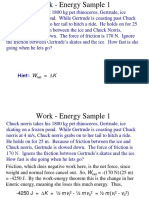0 ratings0% found this document useful (0 votes)
7 viewsPotential and Kinetic Energy
Potential and Kinetic Energy
Uploaded by
juliana.mldy14Copyright:
© All Rights Reserved
Available Formats
Download as PDF, TXT or read online from Scribd
Potential and Kinetic Energy
Potential and Kinetic Energy
Uploaded by
juliana.mldy140 ratings0% found this document useful (0 votes)
7 views3 pagesCopyright
© © All Rights Reserved
Available Formats
PDF, TXT or read online from Scribd
Share this document
Did you find this document useful?
Is this content inappropriate?
Copyright:
© All Rights Reserved
Available Formats
Download as PDF, TXT or read online from Scribd
Download as pdf or txt
0 ratings0% found this document useful (0 votes)
7 views3 pagesPotential and Kinetic Energy
Potential and Kinetic Energy
Uploaded by
juliana.mldy14Copyright:
© All Rights Reserved
Available Formats
Download as PDF, TXT or read online from Scribd
Download as pdf or txt
You are on page 1of 3
Potential and Kinetic Energy
Learning Objectives:
1. Understand the formulas and applications of potential and kinetic energy.
2. Calculate unknowns for potential and kinetic energy in various scenarios.
3. Analyze energy transformation between potential and kinetic energy and interpret results.
4. Understand the concept of energy conservation in closed systems.
Part 1: Conceptual Discussion
What is Potential Energy (PE)?
Potential energy is the energy stored within an object due to its position or state. In physics, gravitational
potential energy, one of the most common forms, is energy an object possesses because of its height in a
gravitational field.
The formula for gravitational potential energy is:
PE=m⋅g⋅h
where:
• m = mass of the object in kilograms (kg)
• g = acceleration due to gravity, approximately 9.8 m/s² on Earth
• h = height of the object above a reference point in meters (m)
For example, a rock held at the top of a cliff has a certain amount of potential energy based on its mass
and height from the ground. This energy is "stored" and can be released when the rock is dropped, at
which point it begins converting to kinetic energy as it falls.
What is Kinetic Energy (KE)?
Kinetic energy is the energy an object has due to its motion. It depends on the mass and velocity of the
moving object. The formula for kinetic energy is:
KE=1/2mv2
where:
• m = mass in kilograms (kg)
• v = velocity of the object in meters per second (m/s)
The faster an object moves, the more kinetic energy it has. For instance, a car moving at high speed has
significantly more kinetic energy than one moving slowly.
Energy Conservation and Transformation
In an ideal system (without air resistance or friction), energy conservation dictates that the total
mechanical energy (sum of potential and kinetic energy) remains constant. This means that when an
object falls, its potential energy decreases while its kinetic energy increases, keeping the total energy
unchanged.
For example:
1. When an object is at rest at a height, it has maximum potential energy and zero kinetic energy.
2. As it begins to fall, potential energy is converted to kinetic energy.
3. At the lowest point, potential energy is minimized, while kinetic energy is maximized.
Part 2: Problem Sets with Solutions and Explanations
Problem 1: Calculating Potential Energy at Various Heights
Scenario: A 5 kg rock is held at different heights.
1. Calculate the potential energy of the rock at:
o Height h=20m
o Height h=10m
o Height h=5m
Solutions:
PE=m⋅g⋅h
Using m=5 kg and g=9.8 m/s2
• For h=20 m: PE=5⋅9.8⋅20=980 J
• For h=10 m: PE=5⋅9.8⋅10=490 J
• For h=5m: PE=5⋅9.8⋅5=245 J
Explanation: As height decreases, the potential energy decreases proportionally, illustrating that an
object’s potential energy is directly dependent on its height above a reference point.
Problem 2: Kinetic Energy at Different Speeds
Scenario: A 1000 kg car is moving at varying speeds. Calculate its kinetic energy at:
• v=10 m/s
• v=20 m/s
• v=30 m/s
Solutions:
Using m=1000 kg
• For v=10 m/s = 50,000J
• For v=20 m/s=200,000J
• For v=30 m/s =450,000J
Explanation: Kinetic energy is proportional to the square of the velocity. Therefore, doubling the speed
quadruples the kinetic energy, showing the non-linear relationship between speed and kinetic energy.
Problem 3: Energy Conservation in a Falling Object
Scenario: A 2 kg ball is dropped from a height of 50 meters. Calculate:
1. The potential energy at 50 meters.
2. The kinetic energy at 25 meters.
3. The velocity of the ball at 25 meters.
Solutions:
1. Initial Potential Energy at 50 meters: PE=m⋅g⋅h=2⋅9.8⋅50=980 J
2. Potential Energy at 25 meters: PE=2⋅9.8⋅25=490 J
3. Kinetic Energy at 25 meters: KE=Total Energy−Potential Energy=980−490=490 J
4. Velocity at 25 meters ≈ 22.14m/s
Explanation: The total energy remains constant (980 J). As the ball falls, potential energy is converted to
kinetic energy, exemplifying energy conservation.
Problem 4: Roller Coaster Energy Transformation
Scenario: A roller coaster car of mass 800 kg starts at 40 meters high with a speed of 5 m/s. Determine:
1. The total energy at the top.
2. The speed of the car at 10 meters, assuming no energy loss.
Solutions:
1. Total Energy at the Top (sum of PE and KE): PE=m⋅g⋅h = 313,600J
2. KE =323,600J
3. Total Energy at 10 meters: PE 10m =78,400J
4. KE10m=245,200J
5. Solving for v using KE ≈24.8m/s
Explanation: As the roller coaster descends, potential energy is converted into kinetic energy. The
constant total energy highlights energy conservation in the absence of external forces like friction.
Activity 1. Solve for the unknown:
1. A 250 J gravitational potential energy is observed in a 5 kg object. At what height above the ground is
the object located?
Answer: 5.1 m
2. A ball with a mass of 0.5 kg has a kinetic energy of 20 J. What is the ball’s speed?
Answer: 8.94 m/s
3. A 10 kg suitcase is lifted to a height of 2 meters, gaining 196 J of potential energy. What is the
acceleration due to gravity in this context?
Answer: 9.8 m/s²
4. An object has a kinetic energy of 500 J while moving at a speed of 20 m/s. What is the object’s mass?
Answer: 2.5 kg
5. A 3 kg rock has a potential energy of 294 J. If it was lifted on a different planet where gravity is
stronger, and its height is 7 meters, calculate the gravitational acceleration on this planet.
Answer: 14 m/s²
6. A cyclist and bicycle have a combined kinetic energy of 1,800 J and a total mass of 60 kg. What is their
velocity?
Answer: 7.75 m/s
7. A 15 kg crate is placed on a platform 10 meters high, and the gravitational potential energy is
calculated as 1,470 J. What is the gravitational acceleration acting on the crate?
Answer: 9.8 m/s²
8. A car moving at 30 m/s has a kinetic energy of 450,000 J. What is the car's mass?
Answer: 1,000 kg
9. A 2 kg object is dropped, and it reaches a speed of 6.26 m/s just before hitting the ground. What is its
kinetic energy at this point?
Answer: 39.2 J
10. A 4 kg box is lifted, resulting in a gravitational potential energy of 400 J. What height did it reach?
Answer: 10.2 m
11. A 2 kg ball is dropped from a height of 20 meters. Ignoring air resistance, calculate the ball’s kinetic
energy just before it hits the ground. ((Use g=9.8 m/s2.)
Answer: 392 J
12. A rock with a mass of 0.5 kg is dropped from a cliff. Just before hitting the ground, it has a kinetic
energy of 98 J. From what height was the rock dropped?
Answer: 20 m
13. An object with a mass of 3 kg is dropped from a certain height and has a speed of 12 m/s just before it
reaches the ground. Calculate the kinetic energy of the object at that moment.
Answer: 216 J
14. A 10 kg object falls freely from a height of 50 meters. Find its speed just before it hits the ground by
first calculating its kinetic energy upon impact. (Use g=9.8 m/s2.)
Answer: 31.3 m/s
15. A 4 kg object is dropped from a height of 10 meters. What is its kinetic energy just before it reaches
the ground? (Use g=9.8 m/s2.)
Answer: 392 J
Reflection Questions
1. What is the significance of height in potential energy calculations?
2. Why does kinetic energy increase faster with increasing speed?
3. How does energy conservation help us predict changes in a system?
You might also like
- ELM 361 RS 5E Instructional Model TemplateDocument7 pagesELM 361 RS 5E Instructional Model TemplateBrittany AndersonNo ratings yet
- SCI8 Q1 M3 Factors Affecting Potential and Kinetic EnergyDocument16 pagesSCI8 Q1 M3 Factors Affecting Potential and Kinetic EnergyKash cash100% (1)
- Energy Grade 10 IGCSEDocument9 pagesEnergy Grade 10 IGCSEsamiksha dudeja100% (1)
- Middle School Choir Presentation Script HandoutDocument5 pagesMiddle School Choir Presentation Script Handoutapi-334651370100% (1)
- Dispute Between A Man and His Ba - TranscribedDocument12 pagesDispute Between A Man and His Ba - TranscribedCarrie Arbuckle100% (1)
- PhysicalScience 15 57Document24 pagesPhysicalScience 15 57L NNo ratings yet
- Work, Energy and Power Notes October 2023Document8 pagesWork, Energy and Power Notes October 2023chihambakwevictor004No ratings yet
- Work Power and EnergyDocument18 pagesWork Power and Energydeguzmanalexander708No ratings yet
- s.2 Physics Notes 2021 1Document79 pagess.2 Physics Notes 2021 1prospire embeleNo ratings yet
- EnergyDocument28 pagesEnergyFaith VijigaNo ratings yet
- Work & EnergyDocument8 pagesWork & EnergyOrlee Villafañe JrNo ratings yet
- MODULE 4 Work Energy and PowerDocument11 pagesMODULE 4 Work Energy and Power23-32108No ratings yet
- Presentation Physics EnglishDocument12 pagesPresentation Physics EnglishhutterincNo ratings yet
- Lesson 2 - KE and GPEDocument14 pagesLesson 2 - KE and GPETalha HossainNo ratings yet
- Physics Handout 7Document4 pagesPhysics Handout 7TristanNo ratings yet
- SCIENCE9 Q4 SLK4 Work-Power-and-EnergyDocument15 pagesSCIENCE9 Q4 SLK4 Work-Power-and-Energyjohndellipang2xNo ratings yet
- 6 02 2022 The MELCs and The 4th Quarter LessonDocument46 pages6 02 2022 The MELCs and The 4th Quarter LessoncatoruNo ratings yet
- General Physics L5Document9 pagesGeneral Physics L5Ronan CanavanNo ratings yet
- Concept 1 Notes - Nature of EnergyDocument12 pagesConcept 1 Notes - Nature of Energyaloisgerbeaux1104No ratings yet
- Conservation of EnergyDocument4 pagesConservation of EnergyERROL PAQUIAONo ratings yet
- SCIENCE 9 - Work Power and EnergyDocument20 pagesSCIENCE 9 - Work Power and EnergykharlynbriannaNo ratings yet
- Kinetic and Potential Energy Worksheet Name: - KEYDocument3 pagesKinetic and Potential Energy Worksheet Name: - KEYBreana Shaw100% (1)
- Kineticl Energy Science 8 PresentationDocument20 pagesKineticl Energy Science 8 PresentationZander BuheNo ratings yet
- 1 Classic Mechanics - Energy - Natural Sciences IIDocument34 pages1 Classic Mechanics - Energy - Natural Sciences IIdayimaninelisaNo ratings yet
- Kinetic and Potential EnergyDocument3 pagesKinetic and Potential EnergyTAE0% (1)
- SCI8 Q1 M3 Factors Affecting Potential and Kinetic EnergyDocument16 pagesSCI8 Q1 M3 Factors Affecting Potential and Kinetic EnergyspencerNo ratings yet
- Note On Work Energy and Power 2024-2025Document4 pagesNote On Work Energy and Power 2024-2025trinitytricolchapelNo ratings yet
- Jss 2 Basic Science Second Term PPT - 2Document75 pagesJss 2 Basic Science Second Term PPT - 2olaideremi7No ratings yet
- Application Math in Physics (Kinetic and Potential Energy)Document16 pagesApplication Math in Physics (Kinetic and Potential Energy)kamalia89No ratings yet
- The Kinetic EnergyDocument2 pagesThe Kinetic EnergyAr-jay P. RodriguezNo ratings yet
- UntitledDocument36 pagesUntitledmuhammad sallehuddin ismailNo ratings yet
- Physics For Engineers - Energy, Work and PowerDocument15 pagesPhysics For Engineers - Energy, Work and PowerVincent VasquezNo ratings yet
- GPE and KEDocument41 pagesGPE and KELilyana DjunaidiNo ratings yet
- Chapter 8-Work, Power and EnergyDocument6 pagesChapter 8-Work, Power and EnergyLesther James CastroNo ratings yet
- Physics For Future Presidents LectureDocument41 pagesPhysics For Future Presidents LectureJohn CrawfordNo ratings yet
- Science 8, Quarter 1 Week 3Document57 pagesScience 8, Quarter 1 Week 3JAMES-SON JUBANENo ratings yet
- PSC1341 Chapter 3Document5 pagesPSC1341 Chapter 3bens082023No ratings yet
- CHP 3 Energy STD 7Document7 pagesCHP 3 Energy STD 7ankitaparekh11No ratings yet
- Work, Energy and PowerDocument30 pagesWork, Energy and PowerINOC, DARLENE KATENo ratings yet
- Workenergy and Power 1Document48 pagesWorkenergy and Power 1itzzgaddiNo ratings yet
- Work, Energy and PowerDocument21 pagesWork, Energy and Powerdela2No ratings yet
- Chapter 4 Work Energy and Power (Lecturer Only)Document52 pagesChapter 4 Work Energy and Power (Lecturer Only)Jerome FizzowNo ratings yet
- Work Power and EnergyDocument33 pagesWork Power and EnergyYfel UndagNo ratings yet
- Work, Energy and PowerDocument23 pagesWork, Energy and Powervibgyorislight100% (1)
- Energy: Energy Is The Ability of A Body or Object To Produce ADocument13 pagesEnergy: Energy Is The Ability of A Body or Object To Produce AJorge Rodríguez SedanoNo ratings yet
- Potential EnergyDocument25 pagesPotential EnergyjobyangdidzcanNo ratings yet
- c083c282a43655ec69532f2704c3993aDocument12 pagesc083c282a43655ec69532f2704c3993aAneilRandyRamdialNo ratings yet
- Kinetic and Potential Energy: Name Course/Year Date of Activity Date of Submission InstructorDocument4 pagesKinetic and Potential Energy: Name Course/Year Date of Activity Date of Submission InstructorryalphawolfNo ratings yet
- Chapter 5 Work and EnergyDocument68 pagesChapter 5 Work and EnergyDylan HNo ratings yet
- Topic 4 - Work, Energy and PowerDocument18 pagesTopic 4 - Work, Energy and Powerche syakirNo ratings yet
- Grade 8 - KE & PEDocument43 pagesGrade 8 - KE & PEThea Cassius FernandezNo ratings yet
- swk10d4 EnergyDocument21 pagesswk10d4 EnergyErayNo ratings yet
- Answer Review Worksheet Day 9Document4 pagesAnswer Review Worksheet Day 9Thanos AvengerNo ratings yet
- 04 Work, Energy and PowerDocument20 pages04 Work, Energy and PowerThamiso GolwelwangNo ratings yet
- PLAN 4 - Senior 1 PhysicsDocument20 pagesPLAN 4 - Senior 1 PhysicspazzagliacarmelaNo ratings yet
- 1B EnergyDocument6 pages1B EnergyjayaniNo ratings yet
- Chapter 4 Work Energy and Power ImpulseDocument52 pagesChapter 4 Work Energy and Power ImpulsePrince Gabriel PascualNo ratings yet
- Chapter 5 "Work and Energy": Honors PhysicsDocument68 pagesChapter 5 "Work and Energy": Honors PhysicsNick Andrew Dequilla NiervaNo ratings yet
- Module 3 WK3 4 Enviromental Science3 4 FinalDocument5 pagesModule 3 WK3 4 Enviromental Science3 4 FinalEunice ManicNo ratings yet
- Work and EnergyDocument5 pagesWork and EnergyAdam ChiangNo ratings yet
- Potential Energy vs. Kinetic Energy - Physics Made Simple - 4th Grade | Children's Physics BooksFrom EverandPotential Energy vs. Kinetic Energy - Physics Made Simple - 4th Grade | Children's Physics BooksNo ratings yet
- The Cat That Walked by HimselfDocument5 pagesThe Cat That Walked by Himselfkayra dale larrauri67% (3)
- DLL-science2 Week 1 22-23Document3 pagesDLL-science2 Week 1 22-23Sheena Claire dela Pe?No ratings yet
- Circular On Spouse PensionDocument2 pagesCircular On Spouse Pensionmustaq.vdb2209No ratings yet
- 1) Introduction To Student Portal & LmsDocument20 pages1) Introduction To Student Portal & Lmsraj_govind212014No ratings yet
- VST Price List 28nov06Document10 pagesVST Price List 28nov06api-3698462No ratings yet
- Miele S5000 Vacuum Cleaner ManualDocument44 pagesMiele S5000 Vacuum Cleaner Manualfrankdoc0% (1)
- Rubric For Making A ClaimDocument2 pagesRubric For Making A Claimapi-240194213100% (1)
- Kubernetes SecurityDocument156 pagesKubernetes Securitysalinob813No ratings yet
- The Indian Weekender 07 June 2019 (Volume 11 Issue 12)Document32 pagesThe Indian Weekender 07 June 2019 (Volume 11 Issue 12)Indian Weekender ReporterNo ratings yet
- CH 3 Nationalism in India Class 10th NotesDocument6 pagesCH 3 Nationalism in India Class 10th Notesagarwalanushka360No ratings yet
- Articles of Association and Its AlterationDocument4 pagesArticles of Association and Its AlterationSahil BainslaNo ratings yet
- Zhukovska V V 2010 English Stylistics FuDocument240 pagesZhukovska V V 2010 English Stylistics FuHazhar OsmanNo ratings yet
- Advanced FA I CHAPTER THREEDocument17 pagesAdvanced FA I CHAPTER THREEDebeli BokaNo ratings yet
- Part 4 RICS Construction Insurance Black BookDocument24 pagesPart 4 RICS Construction Insurance Black BookVasireddy BharatNo ratings yet
- Golf 8 Brochure Pricelist p11dDocument57 pagesGolf 8 Brochure Pricelist p11dLiubomir GeorgievNo ratings yet
- Disney Infinity Monsters Homework HeroDocument4 pagesDisney Infinity Monsters Homework Heroh41nm475100% (1)
- Course Outline, CLOs-PLOs Mapping, Gradind Policy ... EtcDocument3 pagesCourse Outline, CLOs-PLOs Mapping, Gradind Policy ... EtcBilal AhmadNo ratings yet
- MIL Q3 Module 4 REVISEDDocument8 pagesMIL Q3 Module 4 REVISEDE. MaeNo ratings yet
- Moonlight English Sample Y4 - 240925 - 083057Document57 pagesMoonlight English Sample Y4 - 240925 - 083057hadeelheadzNo ratings yet
- Aleluja KantualDocument1 pageAleluja KantualŽan MorovićNo ratings yet
- Subtraction Lesson PlanDocument5 pagesSubtraction Lesson PlanFatima ObaidNo ratings yet
- IPRA and The Regalian DoctrineDocument4 pagesIPRA and The Regalian DoctrineRichel Dean100% (1)
- Part 1 Introduction To The Castle of Otranto by Horace WalpoleDocument6 pagesPart 1 Introduction To The Castle of Otranto by Horace WalpoleBatoul NNo ratings yet
- Audit Report: Audit #: 347, Supplier: SNP CO LTD., Approval Status: Completed, Score: 77.22%Document39 pagesAudit Report: Audit #: 347, Supplier: SNP CO LTD., Approval Status: Completed, Score: 77.22%Sandy NguyễnNo ratings yet
- Maureen Casey vs. WESD: AnswerDocument4 pagesMaureen Casey vs. WESD: AnswerStatesman JournalNo ratings yet
- Ce Prof 4 Midterm OutputDocument3 pagesCe Prof 4 Midterm OutputnuestrojovennuestroNo ratings yet
- Recovering The Lost HeartDocument3 pagesRecovering The Lost HeartMani Gopal DasNo ratings yet

























































































